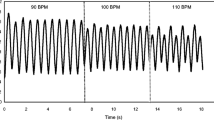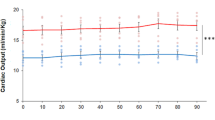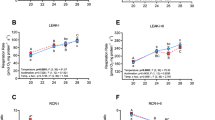Abstract
The trout ventricle has an outer compact layer supplied with well-oxygenated arterial blood from the coronary circulation, and an inner spongy myocardium supplied with oxygen poor venous blood. It was hypothesized that: (1) the spongy myocardium of steelhead trout (Oncorhynchus mykiss), given its routine exposure to low partial pressures of oxygen (PO2), would be better able to maintain contractile performance (work) when exposed to acute hypoxia (100 to 10% air saturation) relative to the compact myocardium, and would show little benefit from hypoxic acclimation; and (2) the compact myocardium from hypoxia-acclimated (40% air saturation) fish would be better able to maintain work during acute exposure to hypoxia relative to normoxia-acclimated individuals. Consistent with our expectations, when PO2 was acutely lowered, net work from the compact myocardium of normoxia-acclimated fish declined more (by ~ 73%) than the spongy myocardium (~ 50%), and more than the compact myocardium of hypoxia-acclimated fish (~ 55%), and hypoxic acclimation did not benefit the spongy myocardium in the face of reduced PO2. Further, while hypoxic acclimation resulted in a 25% (but not significant) decrease in net work of the spongy myocardium, the performance of the compact myocardium almost doubled. This research suggests that, in contrast to the spongy myocardium, performance of the compact myocardium is improved by hypoxic acclimation; and supports previous research suggesting that the decreased contractile performance of the myocardium upon exposure to lowered PO2 may be adaptive and mediated by mechanisms within the muscle itself.





Similar content being viewed by others
References
Altieri AH, Gedan KB (2015) Climate change and dead zones. Glob Change Biol 21:1395–1406
Altringham JD, Johnston IA (1990) Scaling effects on muscle function: power output of isolated fish muscle fibres performing oscillatory work. J Exp Biol 151:453–467
Blank JM, Morrissette JM, Davie PS, Block BA (2002) Effects of temperature, epinephrine and Ca (2+) on the hearts of yellowfin tuna (Thunnus albacares). J Exp Biol 205(Pt 13):1881–1888
Bolli R, Marbán E (1999) Molecular and cellular mechanisms of myocardial stunning. Physiol Rev 79:609–634
Breitburg D, Levin LA, Oschlies A, Grégoire M, Chavez FP, Conley DJ, Garçon V, Gilbert D, Gutiérrez D, Isensee K, Jacinto GS, Limburg KE, Montes I, Naqvi SWA, Pitcher GC, Rabalais NN, Roman MR, Rose KA, Seibel BA, Telszewski M, Yasuhara M, Zhang J (2018) Declining oxygen in the global ocean and coastal waters. Science 5:359
Carnevale C, Roberts JC, Syme DA, Gamperl AK (2020) Hypoxic acclimation negatively impacts the contractility of steelhead trout (Oncorhynchus mykiss) spongy myocardium. Am J Physiol Regul Integr Comp Physiol 318:214–226
Cserne Szappanos H, Viola H, Hool LC (2017) L-type calcium channel: clarifying the “oxygen sensing hypothesis”. Int J Biochem Cell Biol 86:32–36
Diaz RJ (2001) Overview of hypoxia around the world. J Environ Qual 30:275–281
Diaz RJ, Rosenberg R (2008) Spreading dead zones and consequences for marine ecosystems. Science 321:926–929
Driedzic WR, Gesser H (1994) Energy metabolism and contractility in ectothermic vertebrate hearts: hypoxia acidosis, and low temperature. Physiol Rev 74:221–258
Driedzic WR, Gesser H, Johansen K (1985) Effects of hypoxic adaptation on myocardial performance and metabolism of Zoarces viviparus. Can J Zool 63:821–823
Fago A, Jensen FB, Tota B, Feelisch M, Olson KR, Helbo S, Lefevre S, Mancardi D, Palumbo A, Sandvik GK, Skovgaard N (2012) Integrating nitric oxide, nitrite and hydrogen sulfide signaling in the physiological adaptations to hypoxia: a comparative approach. Comp Biochem Physiol A Mol Integr Physiol 162:1–6
Fai AH, Cornelius PL (1996) Approximate F-tests of multiple degree of freedom hypotheses in generalized least squares analyses of unbalanced split-plot experiments. J Stat Comp Sim 54(4):363–378
Farrell AP (1984) A review of cardiac performance in the teleost heart: intrinsic and humoral regulation. Can J Zool 62:523–536
Farrell AP, Jones DR (1992) The Heart. In: Hoar WS, Randall DJ, Farrell AP (eds) Fish physiology 12a: the cardiovascular system. Academic Press Inc., San Diego, pp 26–115
Farrell AP, Richards JG (2009) Defining hypoxia: an integrative synthesis of the responses of fish to hypoxia. In: Richards JG, Farrell AP, Brauner CJ (eds) Fish physiology: Hypoxia, 1st edn. Elsevier, San Diego, pp 487–503
Farrell AP, Smith F (2017) Cardiac form, function and physiology. In: Gamperl AK, Gillis TE, Farrell AP, Brauner CJ (eds) Fish physiology 36a: the cardiovascular system: morphology, control and function. Elsevier, San Diego, pp 155–264
Farrell AP, Eliason EJ, Sandblom E, Clark TD (2009) Fish cardiorespiratory physiology in an era of climate change. Can J Zool 87(10):835–851
Faust HA, Gamperl AK, Rodnick KJ (2004) All rainbow trout (Oncorhynchus mykiss) are not created equal: intra-specific variation in cardiac hypoxia tolerance. J Exp Biol 207:1005–1015
Gamperl AK, Driedzic WR (2009) Cardiovascular function and cardiac metabolism. In: Richards JG, Farrell AP, Brauner CJ (eds) Fish physiology: Hypoxia, 1st edn. Elsevier, San Diego, pp 301–360
Gamperl A, Pinder A, Grant R, Boutilier R (1994) Influence of hypoxia and adrenaline administration on coronary blood flow and cardiac performance in seawater rainbow trout (Oncorhynchus mykiss). J Exp Biol 193:209–232
Gamperl AK, Todgham AE, Parkhouse WS, Dill R, Farrell AP (2001) Recovery of trout myocardial function following anoxia: preconditioning in a non-mammalian model. Am J Physiol Regul Integr Comp Physiol 281:1755–1763
Gesser G, Rodnick KJ (2019) Is the teleost heart oxygen limited? Insights using ‘hyperoxic’ incubations of contracting cardiac tissue from rainbow trout. Comp Biochem Physiol 231A:124–130
Hanson LM, Obradovich S, Mouniargi J, Farrell AP (2006) The role of adrenergic stimulation in maintaining maximum cardiac performance in rainbow trout (Oncorhynchus mykiss) during hypoxia, hyperkalemia and acidosis at 10 °C. J Exp Biol 209:2442–2451
Harwood C, Young I, Altringham J (1998) Influence of cycle frequency, muscle strain and muscle length on work and power production of rainbow trout (Oncorhynchus mykiss) ventricular muscle. J Exp Biol 201:2723–2733
Hool LC (2015) How does the heart sense changes in oxygen tension: a role for ion channels? Antioxid Redox Signal 22:522–536
Icardo JM (2017) Heart morphology and anatomy. In: Gamperl AK, Gillis TE, Farrell AP, Brauner CJ (eds) Fish physiology 36a: the cardiovascular system: morphology, control and function. Elsevier, San Diego, pp 1–54
Joyce W, Ozolina K, Mauduit F, Ollivier H, Claireaux G, Shiels HA (2016a) Individual variation in whole-animal hypoxia tolerance is associated with cardiac hypoxia tolerance in a marine teleost. Biol Lett 12:20150708. https://doi.org/10.1098/rsbl.2015.0708
Joyce W, Simonsen M, Gesser H, Wang T (2016b) The effects of hypoxic bradycardia and extracellular HCO3(-)/CO2 on hypoxic performance in the eel heart. J Exp Biol 219:302–305
Kangur K, Kangur A, Kangur P, Laugaste R (2005) Fish kill in Lake Peipsi in summer 2002 as a synergistic effect of cyanobacterial bloom, high temperature and low water level. Proc Est Acad Sci Biol Ecol 54:67–80
Kuznetsova A, Brockhoff PB, Christensen RHB (2013). lmerTest Package: Tests for random and fixed effects for linear mixed effect models (lmer objects of lme4 package). R package 2.0–11
La VT, Cooke SJ (2011) Advancing the science and practice of fish kill investigations. Rev Fish Sci 19:21–33
Motyka R, Norin T, Petersen LH, Huggett DB, Gamperl AK (2017) Long-term hypoxic exposure alters the cardiorespiratory physiology of steelhead trout (Oncorhynchus mykiss), but does not affect their upper thermal tolerance. J Therm Biol 68B:149–161
Mulholland PJ, Houser JN, Maloney KO (2005) Stream diurnal dissolved oxygen profiles as indicators of in-stream metabolism and disturbance effects: Fort Benning as a case study. Ecol Indic 5:243–252
Petersen LH, Gamperl AK (2010a) In situ cardiac function in Atlantic cod (Gadus morhua): effects of acute and chronic hypoxia. J Exp Biol 213:820–830
Petersen LH, Gamperl AK (2010b) Effect of acute and chronic hypoxia on the swimming performance, metabolic capacity and cardiac function of Atlantic cod (Gadus morhua). J Exp Biol 213:808–819
Petersen LH, Gamperl AK (2011) Cod (Gadus morhua) cardiorespiratory physiology and hypoxia tolerance following acclimation to low-oxygen conditions. Physiol Biochem Zool 84:18–31
Roberts JC, Syme DA (2018) Effects of epinephrine exposure on contractile performance of compact and spongy myocardium from rainbow trout (Oncorhynchus mykiss) during hypoxia. Fish Physiol Biochem 44:49–62
Rodnick KJ, Gesser H (2017) Cardiac energy metabolism. In: Gamperl AK, Gillis TE, Farrell AP, Brauner CJ (eds) Fish Physiology 36a: the cardiovascular system: morphology, control and function. Elsevier, San Diego, pp 317–367
SAS Institute Inc. (2012) SAS user’s guide: statistics. SAS for windows, version 9.4. SAS Institute Inc. Cary
Scaringi JA, Rosa AO, Morad M, Cleemann L (2013) A new method to detect rapid oxygen changes around cells: how quickly do calcium channels sense oxygen in cardiomyocytes? J Appl Physiol 115:1855–1861
Shiels HA, Santiago DA, Galli GLJ (2010) Hypercapnic acidosis reduces contractile function in the ventricle of the Armored catfish Pterygoplichthys pardalis. Physiol Biochem Zool 83(2):366–375
Stecyk JAW (2017) Cardiovascular function under limiting oxygen conditions. In: Gamperl AK, Gillis TE, Farrell AP, Brauner CJ (eds) Fish Physiology 36b: the cardiovascular system: development, plasticity and physiological responses. Elsevier, San Diego, pp 299–371
Syme DA (1993) Influence of extent of muscle shortening on work from frog heart trabeculae and heart rate. Am J Physiol 265:R310–319
Syme DA, Josephson RK (1995) Influence of muscle length on work from trabecular muscle of frog atrium and ventricle. J Exp Biol 198:2221–2227
Syme DA, Gamperl AK, Nash GW, Rodnick KJ (2013) Increased ventricular stiffness and decreased cardiac function in Atlantic cod (Gadus morhua) at high temperatures. Am J Physiol Regul Integr Comp Physiol 305:864–876
Thomas S, Fritsche R, Perry SF (1994) Pre- and post-branchial blood respiratory status during acute hypercapnia or hypoxia in rainbow trout, Oncorhynchus mykiss. J Comp Physiol B 164:451–458
Acknowledgements
We thank Mr. Danny Boyce and the staff of the Dr. Joe Brown Aquatic Research Building for assistance with fish care. This research was supported by Natural Sciences and Engineering Research Council of Canada Discovery grants to AKG (249926-2011) and DAS (201190-2012), and an NSERC Accelerator grant to AKG (412325-2011). During these studies CC was supported by a Memorial University School of Graduate Studies fellowship.
Funding
This research was supported by Natural Sciences and Engineering Research Council of Canada Discovery grants to AKG (249926-2011) and DAS (201190-2012), and an NSERC Accelerator grant to AKG (412325-2011). During these studies CC was supported by a Memorial University School of Graduate Studies fellowship.
Author information
Authors and Affiliations
Contributions
AKG and DAS contributed to the study conception and design. Material preparation, data collection and analysis were performed by AKG, DAS, CC and JCR. The first draft of the manuscript was written by JCR and all authors commented on previous versions of the manuscript. All authors read and approved the final manuscript.
Corresponding author
Ethics declarations
Conflict of interest
The authors declare that they have no conflict of interest.
Ethics approval
All applicable international, national, and institutional guidelines for the care and use of animals were followed. All animal care and handling procedures were approved by the animal care committees of both the University of Calgary (Protocol #AC14-0214) and Memorial University of Newfoundland (Protocol #15-89-KG), and followed guidelines of the Canadian Council on Animal Care.
Availability of data and material
All authors attest that all data and materials as well as software application or custom code support their published claims and comply with field standards. All data generated or analysed during this study are included in this published article.
Additional information
Communicated by B. Pelster.
Publisher's Note
Springer Nature remains neutral with regard to jurisdictional claims in published maps and institutional affiliations.
Rights and permissions
About this article
Cite this article
Roberts, J.C., Carnevale, C., Gamperl, A.K. et al. Effects of hypoxic acclimation on contractile properties of the spongy and compact ventricular myocardium of steelhead trout (Oncorhynchus mykiss). J Comp Physiol B 191, 99–111 (2021). https://doi.org/10.1007/s00360-020-01318-w
Received:
Revised:
Accepted:
Published:
Issue Date:
DOI: https://doi.org/10.1007/s00360-020-01318-w




